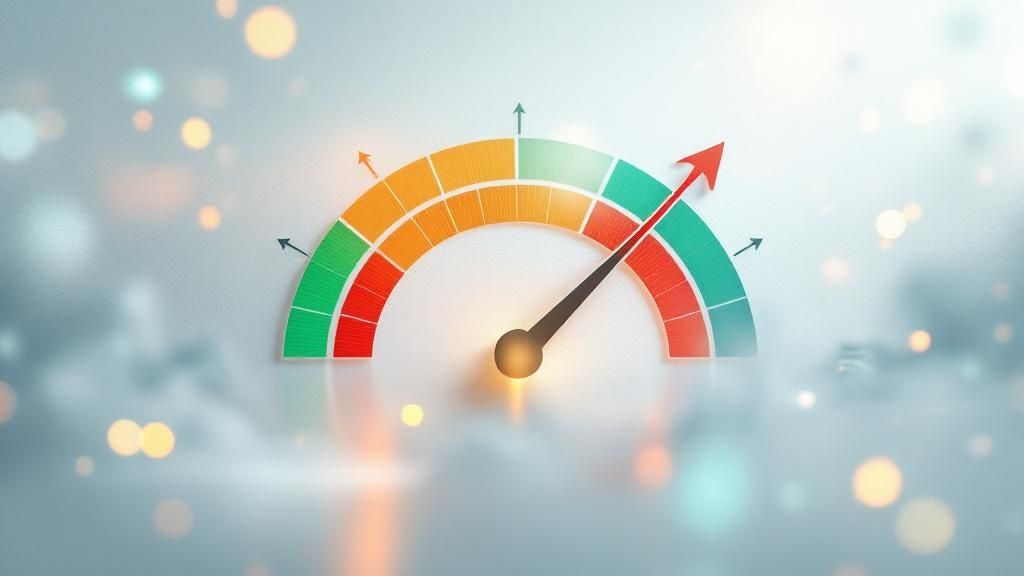
NAMV vs NSC: Which Livestock Valuation Method is Right for Your Farm?
May 1, 2025
Accountants Near East Tamaki: Your Local Partners for Business Growth and Compliance
May 6, 2025What Is Times Interest Earned Ratio? A Clear Guide
Ever heard of the Times Interest Earned (TIE) ratio? It’s a crucial financial metric that basically asks a simple question: how many times over can your business pay its interest bill using the money it makes from its actual operations?
Think of it as a financial safety net. A higher TIE ratio means you have more breathing room. It’s a green light for lenders and investors, showing them your company is in good financial shape and can easily handle its debt.
Your Quick Guide To The TIE Ratio
Let’s bring this home with a personal analogy. Say you earn $5,000 a month after taxes, and your total monthly loan payments (car, personal loan, etc.) are $1,000. You can cover that debt five times over. That simple idea is exactly what the TIE ratio does for a business, just on a much bigger scale. It offers a straightforward, universal way to judge how well a company is managing its debt.
For small and medium-sized businesses, getting a handle on the times interest earned ratio is way more than just a bookkeeping chore—it’s a key tool for survival and growth. This single number answers the one question every lender, investor, or even manager needs to know: “Is this business making enough profit from its day-to-day operations to comfortably pay the interest on its loans?”
The Core Components Of The TIE Ratio
To really get what the TIE ratio is telling you, it helps to look at its two main ingredients. Each one reveals something important about your business’s financial health.
Key Takeaways Of The TIE Ratio
| Component | What It Represents | Why It’s Important |
|---|---|---|
| EBIT | Your company’s raw profit from its main business operations. | Shows the core earning power of the business, independent of financing and tax strategies. |
| Interest Expense | The total cost of the company’s borrowed funds for a given period. | Represents the mandatory cost of debt that must be paid to avoid default. |
In short, these two components give you a clear snapshot of operational profitability versus debt obligations. It’s a fundamental check-up for any business owner looking to grow sustainably.
How To Calculate The Times Interest Earned Ratio
Alright, let’s roll up our sleeves and get into the numbers. Calculating the times interest earned (TIE) ratio is actually a lot simpler than its fancy name might suggest. It all comes down to a single, powerful formula that tells you exactly how many times over your operating profit can cover your interest payments.
The TIE Ratio Formula Unpacked
The formula itself is clean and straightforward, making it one of the most useful business accounting ratios you can have in your toolkit.
Times Interest Earned Ratio = EBIT / Interest Expense
Let’s quickly break down the two numbers you’ll need to pull from your income statement.
- EBIT (Earnings Before Interest and Taxes): Think of this as your company’s raw, unfiltered profit from its day-to-day operations. It’s the cash you’ve made before you’ve paid a dime in loan interest or corporate taxes. EBIT gives you a pure, honest look at your operational performance.
- Interest Expense: This is simply the total cost of your borrowed funds for a given period. It’s the amount you’re legally on the hook for with your lenders.
You’ll find both EBIT and your interest expense listed on your company’s earnings reports. If you’re new to this, getting comfortable with reading earnings reports like an expert is a great first step.
A Practical Example: A Local Coffee Shop
Theory is great, but let’s see how this plays out in the real world. Imagine a local coffee shop, “The Daily Grind,” wants to do a quick financial health check for the past year.
Here are their numbers:
- Find the EBIT: After pulling up their income statement, the owners of The Daily Grind see their Earnings Before Interest and Taxes for the year was $80,000. This is all the profit they made selling coffee and pastries, minus operating costs, but before dealing with loans or taxes.
- Find the Interest Expense: A while back, they took out a loan to upgrade their espresso machines. The total interest they paid on that loan over the year came out to $10,000.
- Calculate the TIE Ratio: Now, we just pop those numbers into our formula:
- TIE Ratio = $80,000 (EBIT) / $10,000 (Interest Expense)
- TIE Ratio = 8.0
What does this tell us? It means The Daily Grind earned enough money from its operations to cover its annual interest bill a comfortable eight times over. That’s a really strong TIE ratio, and it sends a clear signal to any potential lenders or investors that the business is financially stable and can easily handle its debt.
A result like 8.0 shows a very healthy capacity to service debt, dramatically lowering the perceived risk of default. It’s a sign of a well-run, profitable business.
What’s a Good TIE Ratio for Your Business?

Okay, so you’ve crunched the numbers and have your Times Interest Earned (TIE) ratio. Now what? A number on its own is just data; the magic is in understanding what it’s telling you about your business’s financial stability. Think of it as a quick health check for your company’s relationship with debt.
Generally speaking, a higher TIE ratio is almost always a good thing. It’s a strong signal to lenders, investors, and even your own leadership team that your business has plenty of breathing room to cover its interest payments. A high number shows you have enough operating profit to handle your debt obligations without breaking a sweat, even if sales take an unexpected dip.
Benchmarks and Red Flags
While every company’s situation is different, there are some handy rules of thumb that can help you make sense of your TIE ratio. For instance, most lenders want to see a ratio of at least 2.0 as a bare minimum. If you dip below 1.5, you can bet some eyebrows will be raised, as it suggests you’re cutting it a little too close.
Let’s break it down with a simple traffic light analogy:
- Green Light (Safe Zone): A TIE ratio of 4.0 or higher is fantastic. This means your business is earning more than enough to cover its interest costs several times over. It tells the world you’re low-risk and financially solid.
- Yellow Light (Caution Zone): A ratio between 2.0 and 3.9 is still considered pretty healthy. You’re comfortably making your interest payments, but you don’t have a massive safety net. It’s a good spot to be in, but you should keep an eye on it.
- Red Light (High-Risk Zone): A ratio below 2.0, and especially one that creeps under 1.5, is a clear warning sign. Your margin for error is razor-thin. Even a small drop in profits could make it difficult to pay your interest, which puts you at a higher risk of default.
A TIE ratio of less than 1.0 is a five-alarm fire. It means your operating profit for the period wasn’t even enough to cover the interest bill. You’re likely dipping into cash reserves or, even worse, taking on more debt just to keep up.
Why Industry Context Is Everything
Now, here’s a crucial point: a “good” TIE ratio isn’t a universal number. What’s considered excellent in one industry might be just average—or even concerning—in another. It all comes down to how capital-intensive the business model is.
Take a software company, for example. They usually have low debt and high profit margins, so a TIE ratio of 10.0 or more isn’t out of the ordinary. They don’t need to finance fleets of trucks or massive factories.
On the flip side, think about a construction firm or a heavy manufacturing plant. These businesses require huge investments in equipment and facilities, much of which is financed with debt. For them, a TIE ratio of 3.0 might be considered incredibly strong.
Comparing your software-as-a-service startup to a construction giant is like comparing apples to oranges. That’s why the most insightful analysis comes from benchmarking your TIE ratio against the average for your specific industry. This gives you a much clearer, more realistic picture of how you stack up against your direct competitors.
Why the TIE Ratio is a Big Deal for Your Business
Forget dusty accounting textbooks. The times interest earned (TIE) ratio is one of the most practical numbers you can track. Think of it as a financial stress test for your company—a quick, honest look at how well you’re handling your debt.
It’s like your business’s credit score. A strong one opens doors to better opportunities, while a weak one can slam them shut.
A Litmus Test for Lenders
Before a lender even thinks about giving you a loan, they’re going to look at your TIE ratio. Why? It’s their go-to metric for figuring out how risky you are. A high ratio tells them your business is pulling in more than enough profit to comfortably handle its interest payments.
This isn’t just about getting approved. A good TIE ratio can help you snag better loan terms, lower interest rates, and bigger lines of credit. On the flip side, a low number is a major red flag, screaming that even a small slump in sales could push you dangerously close to default.
Your Business’s Built-In Early Warning System
The TIE ratio is more than just a tool for getting loans; it’s a powerful health check you can run yourself. It acts as an early warning system, flagging problems with your profitability or debt load long before they spiral out of control.
Is your TIE ratio slipping quarter after quarter? That’s a sign to dig deeper. Maybe your operating costs are creeping up, or perhaps you’ve taken on too much debt too quickly. Catching these trends early gives you the runway to fix them—whether that means improving your profit margins or refinancing your loans—before things get dire. Having a firm grip on this is a core part of any smart ultimate guide to business scaling strategies.
Watch Out for These Common TIE Ratio Pitfalls
The times interest earned ratio is a brilliant tool, but it’s not a silver bullet. Like any financial metric, it has its blind spots. If you’re not careful, you can easily misinterpret the numbers and get a warped sense of your company’s financial stability.
Let’s be honest, seeing a TIE ratio of 4.0 feels good. But what does that number really tell you on its own? Not much. Without context, it’s just a number floating in space.
To get the full story, you have to look at it from a couple of different angles. That’s when the data starts to talk.
Forgetting to Check Trends and Industry Norms
To make the TIE ratio work for you, you need to compare it to something. Think of it this way: a single snapshot is nice, but it doesn’t show you the movie.
- Your Own History: How does this quarter’s TIE ratio look compared to last quarter’s? Or this time last year? A downward trend, even if the ratio is still technically “healthy” (say, above 2.0), is a red flag. It could signal that your profits are getting squeezed or your debt costs are creeping up.
- Your Competition: How do you stack up against others in your field? A construction business might be doing great with a TIE of 3.0, but for a software company, that same number could be a sign of trouble. Different industries have different standards.
Skipping these comparisons is a classic mistake. It can either give you a false sense of security or cause you to panic for no reason. It’s the context that transforms a simple number into a powerful insight.
Using the Wrong “Earnings” Number
Here’s another classic trip-up: grabbing the wrong earnings figure for your calculation. The standard formula calls for EBIT (Earnings Before Interest and Taxes), but sometimes people swap in EBITDA (Earnings Before Interest, Taxes, Depreciation, and Amortization). This can paint a dangerously rosy picture.
Sure, depreciation and amortization aren’t cash expenses you pay out each month. But they represent the very real, gradual cost of your assets wearing out. Sooner or later, that truck, computer, or piece of machinery will need to be replaced, and that takes cold, hard cash.
Using EBITDA will almost always give you a higher, more flattering TIE ratio. But EBIT is the more conservative—and frankly, more realistic—choice. It accounts for the slow decay of your assets, giving you a much truer picture of your long-term ability to handle interest payments.
By sticking with EBIT, you’re keeping your analysis grounded in reality. It helps you understand your true operational profitability and prevents you from overestimating your financial muscle, ensuring your decisions are based on solid ground.
At Business Like NZ Ltd, we help small and medium-sized businesses in Auckland get a crystal-clear picture of their financial health. If you’re looking for expert advice on how to use metrics like the TIE ratio to build a solid financial strategy, we’re here for you. Learn more about how we can help on our website.




